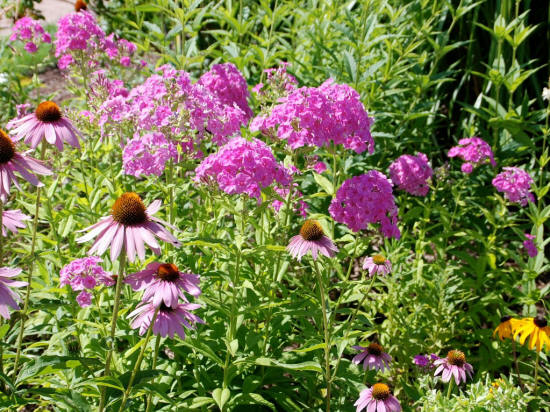|
 Phlox
Adds Color and Pollinator Appeal to the Garden All Season Long Phlox
Adds Color and Pollinator Appeal to the Garden All Season Long
By Melinda Myers
 Send a link to a friend
Send a link to a friend
[July 18, 2022]
Fill your gardens with color from spring
through summer and even into fall with a variety of
pollinator-friendly phlox. The beauty, diversity, and usefulness in
the garden of this group of plants had the National Garden Bureau
declare 2022 Year of the Phlox.
|
|
 Start out the growing season with creeping phlox
(Phlox subulata). This low growing phlox is perfect for rock
gardens, as a groundcover or planted at the front of a perennial
garden. Grow it in full sun with well-drained soil in zones three to
nine. Once the flowers fade, shear the plants back halfway to
encourage attractive new growth that will last all season long. Start out the growing season with creeping phlox
(Phlox subulata). This low growing phlox is perfect for rock
gardens, as a groundcover or planted at the front of a perennial
garden. Grow it in full sun with well-drained soil in zones three to
nine. Once the flowers fade, shear the plants back halfway to
encourage attractive new growth that will last all season long.
Woodland phlox (Phlox divaricata) is native to Midwestern woods and
fields and hardy in zones three to eight. The periwinkle blue
flowers add some welcome color to shady spots in spring. Grow it in
moist rich soil and watch for hummingbirds and butterflies that
visit the blooms.
The Garden Club of America named Blue Moon woodland phlox its Plant
of the Year, awarding it with the 2022 Montine McDaniel Freeman
Horticulture Award. This award is given to native underutilized
plants with superior ecological and ornamental attributes. Their
goal is to increase the use of these plants in gardens. Blue Moon is
mildew resistant, long blooming and like the species is an early
source of pollen for native bees, swallowtail butterflies and nectar
for the hummingbirds.

Downy or prairie phlox (Phlox pilosa) is another North American
native phlox that can be found in prairies and is hardy in zones
three to nine. The pale pink to purple-pink blossoms appear in
spring. Grow it in full sun with moist to well-drained loam or sandy
soils. Like other phlox, it attracts and supports butterflies and
hummingbirds.
Marsh phlox (Phlox globerrima) is native to wet prairies and open
woodlands and thrives in moist soil and even damp clay. The intense
magenta flowers appear June to July and are a hummingbird magnet.
Grow this phlox in zones four to eight.
[to top of second column] |

The North American native tall garden phlox has long
been popular with gardeners. It blooms mid-season, adding color and
height to any garden bed or mixed border. The perfectly round flower
clusters top each stem and come in a variety of colors from white to
pink, purple, salmon and more. Grow these in full sun with moist,
rich well-drained soil.
The flowers of many tall phlox varieties are fragrant, attract
pollinators and make great cut flowers. Remove faded flowers and
provide sufficient moisture and nutrients to encourage more blooms.
The Fashionably Early series of tall phlox bloom early and for a
long period with rebloom in fall.
Grow tall phlox in full sun, provide sufficient space and avoid
overhead watering to reduce the risk of powdery mildew. Select
mildew resistant varieties like LUMINARY™, Opening Act, Sweet Summer
and Super Ka-pow to reduce the risk of this disease.
Consider adding a variety of phlox plants to your garden this season
or next. You and the pollinators will appreciate the long season of
beautiful flowers, pollen, and nectar.
Melinda Myers has written more than 20 gardening books, including
the recently released Midwest Gardener’s Handbook, 2nd Edition and
Small Space Gardening. She hosts The Great Courses “How to Grow
Anything” DVD instant video series and the nationally syndicated
Melinda’s Garden Moment TV & radio program. Myers is a columnist and
contributing editor for Birds & Blooms magazine and her website is
www.MelindaMyers.com.
[Photo courtesy of MelindaMyers.com] |